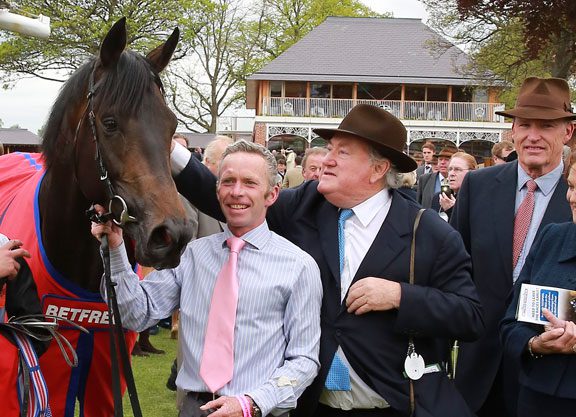Notice: Trying to access array offset on value of type null in /var/www/vhosts/dev.thoroughbreddailynews.com/wp-content/plugins/pmadv-insert-ads/pmadv-insert-ads.php on line 33
Even before Golden Horn passed the post in the G1 Coral-Eclipse S., it was most unlikely he would remain in training as a 4-year-old. Now that he has proved himself against the older generation, it is a virtual certainty that we will not see him in 2016.
This longstanding problem has never been more important to solve than now. Yet the sport has it within its power to lower the rate at which star 3-year-olds disappear to stud: reduce the weight-for-age allowance in Europe.
In Britain, 3-year-olds defeat older horses in handicaps no less that 41% more often than random chance. The longer the distance of a race, the more the weight-for-age allowance, the greater the advantage 3-year-olds enjoy (this is true even when correcting for the different profiles 3- and 4-year-olds have, and it stands up to advanced statistical analysis such as significance testing).
After allotting Golden Horn a rating of 130 for his performance in the Eclipse, the British Horseracing Authority's chief handicapper, Phil Smith, said while the unbeaten colt was likely to score even higher on the official ratings scale, “Life will become harder for Golden Horn as the 3-year-old weight-for-age allowance reduces by two pounds per month across each distance.”
Exactly. Life will become harder because the weight-for-age scale is supposed to reflect the progress of the average 3-year-old, but the best 3-year-olds are, by nature of their dominance, likely to be ahead of their contemporaries, even if it doesn't appear so physically.
Smith is dead right: as time goes by, Golden Horn won't be at such an advantage. But he shouldn't be at an advantage at all.
Even if the sport followed the maths and reduced the allowance by pounds or so at longer distances, the best 3-year-olds will still be able to win the best weight-for-age races–Golden Horn scored by 3 1/2 lengths, after all–but the point is that these races will fall less to marginal contenders and won't be seen as relatively easy pickings.
There is no immutable law compelling the sport to allow 3-year-olds allowances like the 11 pounds Golden Horn received at Sandown. They don't allow 18-year-olds a five-meter start in the Olympic 400 meter or rookies a three-shot break in the Masters. Thoroughbred racing is, of course, governed by different motivations, and a weight-for-age allowance of some sort is required to facilitate competition among the generations. But the scale is out of date after generations of breeding that implicitly selects for precocity; and there is nothing to say it can't be reduced to the same level used in other countries.
In last year's GI Jockey Club Gold Cup over ten furlongs at Belmont in late September, for example, the 3-year-old Tonalist beat older horses in receipt of just four pounds. But 3-year-olds receive double that in the Prix de l'Arc de Triomphe at Longchamp.
Why? Three-year-olds have won nine of the last 12 Arcs, and even when correcting for the quality of each generation's representation, it is obvious to anyone in the sport that they catch a break at the weights.
Racing, particularly in Britain, is resistant to change. The most powerful owners and trainers don't want the allowance reduced because they benefit from it; the major racecourses don't want the allowance reduced because they fear that three-year-olds would not turn up for races like the Eclipse and Ascot's King George VI and Queen Elizabeth II S.–Golden Horn's next target.
But this is short-sighted. Self-interest is no excuse for specious argument. Perhaps the connections of 3-year-olds may be less attracted to these races in Year One, but the point is they are far more likely to stay around to compete in future renewals.
The sport must do everything it can to encourage top-class horses to stay in training as, thankfully, Frankel did in 2012. Even then, the great horse raced just 14 times, which isn't much more than a third of the English Premier League Campaign, or a twelfth of the regular season in Major League Baseball.
Golden Horn's owner, Anthony Oppenheimer, said, “As for racing [Golden Horn] next year, I am not enthusiastic. The Arc could easily be his last race. If the ground is soft or heavy, we wouldn't enter.”
This cannot be in the best interests of the game. And while it is too late to do anything to keep this brilliant colt where the public can watch him run, at least there is a potential deterrent for future Golden Horns being rushed off to stud: make 3-year-olds compete on something more like level terms and they may just have to stick around a while.
Not a subscriber? Click here to sign up for the daily PDF or alerts.





